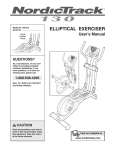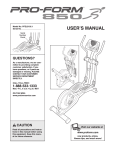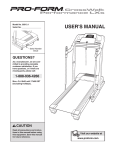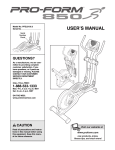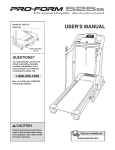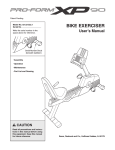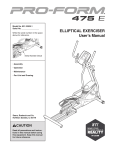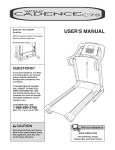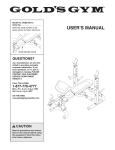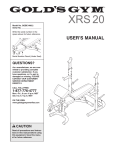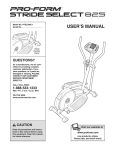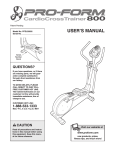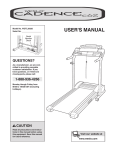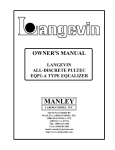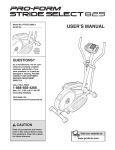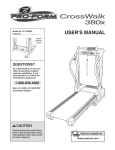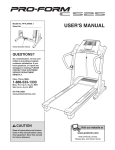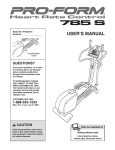Download USER`S MANUAL
Transcript
Model No. PFEL5105.6 Serial No. Write the serial number in the space above for reference. Serial Number Decal USER’S MANUAL QUESTIONS? As a manufacturer, we are committed to providing complete customer satisfaction. If you have questions, or if parts are damaged or missing, PLEASE DO NOT CONTACT THE STORE. For assistance, contact our Customer Service Department CALL TOLL-FREE: 1-888-533-1333 Mon.–Fri., 6 a.m.–6 p.m. MST Sat. 8 a.m.–4 p.m. MST ON THE WEB: www.proformservice.com CAUTION Read all precautions and instructions in this manual before using this equipment. Keep this manual for future reference. Visit our website at www.proform.com new products, prizes, fitness tips, and much more! TABLE OF CONTENTS WARNING DECAL PLACEMENT . . . . . . . . . . . . . . . . . . . . . . . . . . . . . . . . . . . . . . . . . . . . . . . . . . . . . . . . . . . . . .2 IMPORTANT PRECAUTIONS . . . . . . . . . . . . . . . . . . . . . . . . . . . . . . . . . . . . . . . . . . . . . . . . . . . . . . . . . . . . . . . .3 BEFORE YOU BEGIN . . . . . . . . . . . . . . . . . . . . . . . . . . . . . . . . . . . . . . . . . . . . . . . . . . . . . . . . . . . . . . . . . . . . . .4 ASSEMBLY . . . . . . . . . . . . . . . . . . . . . . . . . . . . . . . . . . . . . . . . . . . . . . . . . . . . . . . . . . . . . . . . . . . . . . . . . . . . . . .5 HOW TO USE THE ELLIPTICAL EXERCISER . . . . . . . . . . . . . . . . . . . . . . . . . . . . . . . . . . . . . . . . . . . . . . . . . .11 MAINTENANCE AND TROUBLESHOOTING . . . . . . . . . . . . . . . . . . . . . . . . . . . . . . . . . . . . . . . . . . . . . . . . . . .24 EXERCISE GUIDELINES . . . . . . . . . . . . . . . . . . . . . . . . . . . . . . . . . . . . . . . . . . . . . . . . . . . . . . . . . . . . . . . . . . .25 PART LIST . . . . . . . . . . . . . . . . . . . . . . . . . . . . . . . . . . . . . . . . . . . . . . . . . . . . . . . . . . . . . . . . . . . . . . . . . . . . . .28 EXPLODED DRAWING . . . . . . . . . . . . . . . . . . . . . . . . . . . . . . . . . . . . . . . . . . . . . . . . . . . . . . . . . . . . . . . . . . . .30 ORDERING REPLACEMENT PARTS . . . . . . . . . . . . . . . . . . . . . . . . . . . . . . . . . . . . . . . . . . . . . . . . . .Back Cover LIMITED WARRANTY . . . . . . . . . . . . . . . . . . . . . . . . . . . . . . . . . . . . . . . . . . . . . . . . . . . . . . . . . . . . . .Back Cover WARNING DECAL PLACEMENT The warning decal shown at the right has been applied in the location shown. If the decal is missing or illegible, call the telephone number on the front cover of this manual and request a free replacement decal. Apply the decal in the location shown. Note: The decal may not be shown at actual size. 2 246724 246723 IMPORTANT PRECAUTIONS WARNING: To reduce the risk of serious injury, read all important precautions and instructions in this manual and all warnings on your elliptical exerciser before using your elliptical exerciser. ICON assumes no responsibility for personal injury or property damage sustained by or through the use of this product. 1. Before beginning any exercise program, consult your physician. This is especially important for persons over the age of 35 or persons with pre-existing health problems. 8. Wear appropriate exercise clothes when exercising; do not wear loose clothes that could become caught on your elliptical exerciser. Always wear athletic shoes for foot protection. 2. It is the responsibility of the owner to ensure that all users of the elliptical exerciser are adequately informed of all precautions. 9. Hold the handgrip pulse sensor or the handlebars when mounting, dismounting, or using your elliptical exerciser. 3. Your elliptical exerciser is intended for home use only. Do not use your elliptical exerciser in a commercial, rental, or institutional setting. 10. Keep your back straight while using your elliptical exerciser; do not arch your back. 11. The pulse sensor is not a medical device. Various factors, including the user’s movement, may affect the accuracy of heart rate readings. The pulse sensor is intended only as an exercise aid in determining heart rate trends in general. 4. Keep your elliptical exerciser indoors, away from moisture and dust. Place your elliptical exerciser on a level surface, with a mat beneath it to protect the floor or carpet. Make sure that there is enough clearance around your elliptical exerciser to mount, dismount, and use it. 12. When you stop exercising, allow the pedals to slowly come to a stop. 5. Inspect and properly tighten all parts regularly. Replace any worn parts immediately. 13. If you feel pain or dizziness while exercising, stop immediately and cool down. 6. Keep children under age 12 and pets away from your elliptical exerciser at all times. 14. Use your elliptical exerciser only as described in this manual. 7. Your elliptical exerciser should not be used by persons weighing more than 250 lbs. (113 kg). 3 BEFORE YOU BEGIN Thank you for selecting the revolutionary PROFORM® XP 130 elliptical exerciser. The XP 130 elliptical exerciser provides a wide array of features designed to make your workouts at home more effective and enjoyable—and when you’re not exercising, the unique XP 130 can be folded out of the way. product model number and serial number before contacting us. The model number and the location of the serial number decal are shown on the front cover of this manual. To avoid a registration fee for any service needed under warranty, you must register the elliptical exerciser at www.proformservice.com/registration. For your benefit, read this manual carefully before you use the elliptical exerciser. If you have questions after reading this manual, please see the front cover of this manual. To help us assist you, note the Before reading further, please familiarize yourself with the parts that are labeled in the drawing below. Fan Handgrip Pulse Sensor Handlebar Console Storage Magnet Water Bottle Holder* Wheel Pedal Pedal Arm Latch Pedal Disc Storage Latch Handle Leveling Foot *No water bottle is included 4 ASSEMBLY To hire an authorized service technician to assemble the elliptical exerciser, call 1-800-445-2480. Assembly requires two persons. Place all parts of the elliptical exerciser in a cleared area and remove the packing materials. Do not dispose of the packing materials until assembly is completed. In addition to the included hex keys, assembly requires a Phillips screwdriver , an adjustable , and a rubber mallet . wrench As you assemble the elliptical exerciser, use the drawings below to identify small parts. The number in parentheses below each drawing is the key number of the part, from the PART LIST on pages 28 to 29. The second number is the quantity needed for assembly. Note: Some small parts may have been pre-assembled. If a part is not in the parts bag, check to see if it has been pre-assembled. Star Washer (112)–8 M4 x 14mm Screw (104)–8 M8 Split Washer (90)–3 M4 x 32mm Round Head Screw (105)–6 M4 x 16mm Round Head Screw (101)–8 Hub Screw (87)–8 M8 x 23mm Shoulder Screw (115)–4 M10 Nylon Locknut (81)–2 M8 Jamnut (79)–5 M8 Washer (88)–6 Wave Washer (111)–2 M4 x 45mm Screw (108)–2 M8 x 23mm Button Screw (84)–4 M8 x 43mm Button Bolt (78)–4 M10 x 80mm Carriage Bolt (82)–2 M8 x 69mm Button Bolt (80)–1 M10 x 127mm Button Screw (83)–2 5 1. 1 To make assembly easier, read the information on page 5 before you begin assembling the elliptical exerciser. While another person lifts the Base (1), attach the Front Stabilizer (6) to the Base with two M10 x 80mm Carriage Bolts (82) and two M10 Nylon Locknuts (81). 82 81 6 81 2. Remove the indicated screw and bracket from the Base (1). Discard the screw and the bracket. 1 2 Next, turn the Base Foot (26) into the Base (1) as far as possible. 1 26 3. Attach the Rear Stabilizer (7) to the Frame (2) with two M10 x 127mm Button Screws (83). Bracket Screw 3 83 Next, hold the handle on the Frame (2), press the Latch Button (68), and lower the Frame until the Rear Stabilizer (7) is resting on the floor. 7 Handle 2 68 6 4. Hold a Hub Cover (75) and a Crank Arm (36) against the left Crank Hub (38). Align the holes in the Hub Cover and the Crank Arm with the unused holes in the left Crank Hub. Next, insert four Hub Screws (87) into the Hub Cover and the Crank Arm, and finger tighten the Hub Screws into the left Crank Hub. Tighten one of the Hub Screws, and then tighten the Hub Screw across from the first Hub Screw. Then, tighten the remaining two Hub Screws. 4 38 Repeat this step on the right side of the elliptical exerciser; make sure that the Crank Arms (36) are oriented so the Crank Bushing Sleeves (43) are in the positions shown. Note: There are no Pulley Screws (98) on the right side. 5. While another person holds the Upright (3), connect the Upper Wire Harness (48) to the Lower Wire Harness (49). Gently pull the upper end of the Upper Wire Harness to remove any slack, and insert the Upright into the Base (1). Attach the Upright with an M8 x 69mm Button Bolt (80), an M8 Split Washer (90), and an M8 Jamnut (79). Do not tighten the Button Bolt yet; make sure that the Jamnut is in the hexagonal hole in the Base. 87 75 36 43 5 3 80 48 49 79 90 90 84 Attach the Water Bottle Holder (22) to the Base (1) with two M4 x 14mm Screws (104). 1 90 84 104 22 6 Orient one of the Upright Covers (17) as shown, and hold it against the Upright (3). Attach the Upright Cover with two M4 x 16mm Round Head Screws (101). Attach the other Upright Cover in the same way. 17 101 7 98 36 87 Next, finger tighten two M8 x 23mm Button Screws (84) with M8 Split Washers (90) into the Base (1). Do not tighten the Button Screws yet. 6. Insert the end of the Upper Wire Harness (48) through the hole in the Upright (3). 43 3 48 101 17 7. The Console (5) requires four 1.5V “D” batteries (not included); alkaline batteries are recommended. IMPORTANT: If the elliptical exerciser has been exposed to cold temperatures, allow it to warm to room temperature before inserting batteries into the Console. If you do not do this, the console displays or other electronic components may become damaged. Press the two tabs on the battery cover, and remove the battery cover. Next, insert four batteries into the Console. Make sure that the batteries are oriented as shown by the diagrams inside of the battery compartments. Then, reattach the battery cover to the Console. 8. While another person holds the Console (5) near the Upright (3), connect the wire harness on the Console to the Upper Wire Harness (48). Insert the excess wire harness into the Upright. Next, attach the Console to the Upright with four M4 x 16mm Round Head Screws (101). Be careful to avoid pinching the wire harness. 7 Tabs 5 Batteries 8 48 101 9 Orient the Left Handlebar (8) and the Left Upper Body Arm (11) as shown, and insert the Left Handlebar into the Left Upper Body Arm. Attach the Left Handlebar with two M8 x 43mm Button Bolts (78) and two M8 Jamnuts (79). Make sure that the Jamnuts are in the hexagonal holes in the Left Upper Body Arm. 9 8 Attach the Right Handlebar (9) to the Right Upper Body Arm (12) in the same way. 79 11 8 5 Wire Harness 3 9. Identify the Left Handlebar (8) and the Left Upper Body Arm (11), which are marked with stickers. Battery Cover 79 78 78 12 10. Insert the Pivot Axle (74) into the Upright (3) and center it. Apply a generous amount of the included grease to the Pivot Axle. Orient the Left Upper Body Arm (11) as shown, and slide it onto the left end of the Pivot Axle (74). Slide the Right Upper Body Arm (12) onto the right end of the Pivot Axle. Tighten an M8 x 23mm Button Screw (84) with an M8 Washer (88) and a Wave Washer (111) into each end of the Pivot Axle (74). Make sure that the Wave Washers are on the ends of the Pivot Axle. 11. Hold the Left Front Handlebar Cover (18) and the Left Rear Handlebar Cover (19) around the Left Upper Body Arm (11). Attach the Handlebar Covers with three M4 x 32mm Round Head Screws (105). 10 74 88 84 Grease 20 105 12 11 12 Attach the Right Pedal (not shown) to the Right Pedal Leg (not shown) in the same way. 112 104 9 21 19 13 Attach the Left Pedal (13) to the Left Pedal Leg (14) with an M4 x 45mm Screw (108), three M4 x 14mm Screws (104), and four Star Washers (112). 112 108 112 84 12 11 111 18 12. Identify the Left Pedal (13) and the Left Pedal Leg (14), which are marked with stickers. 111 11 Attach the Right Front Handlebar Cover (20) and the Right Rear Handlebar Cover (21) in the same way. 88 3 112 104 14 13. Apply a thin film of grease to one of the Pedal Leg Axles (32) and to the faces of the two Pedal Leg Bushings (33) in the Left Pedal Leg (14). 13 Next, slide an M8 Washer (88) and a Pedal Leg Cover (31) onto an M8 x 23mm Shoulder Screw (115), and turn the Shoulder Screw a few turns into the Pedal Leg Axle (32). 11 While another person holds the front end of the Left Pedal Leg (14) inside of the bracket on the Left Upper Body Arm (11), insert the Pedal Leg Axle (32) into both parts. Next, slide an M8 Washer (88) and a Pedal Leg Cover (31) onto another M8 x 23mm Shoulder Screw (115), and turn the Shoulder Screw a few turns into the Pedal Leg Axle. Tighten both Shoulder Screws. 88 12 88 31 31 115 33 Grease 115 Grease 32 Repeat this step on the other side of the elliptical exerciser. 14. Lift the latch on the underside of the Left Pedal Leg (14), and set the Left Pedal Leg on the left Crank Bushing Sleeve (43). Release the lever, and make sure that the Left Pedal Leg is securely connected to the Crank Bushing Sleeve. Connect the Right Pedal Leg (not shown) in the same way. See step 5. Tighten the M8 x 69mm Button Bolt (80) and the two M8 x 23mm Button Screws (84). 14 14 14 Latch 43 15. Make sure that all parts of the elliptical exerciser are properly tightened. Note: Some hardware may be left over after assembly is completed. To protect the floor or carpet from damage, place a mat under the elliptical exerciser. 10 HOW TO USE THE ELLIPTICAL EXERCISER HOW TO FOLD AND UNFOLD THE ELLIPTICAL EXERCISER When the elliptical exerciser is not in use, the frame can be folded out of the way. First, lift the latch under each pedal leg, and lift the pedal legs off the sleeves on the crank arms. HOW TO MOVE THE ELLIPTICAL EXERCISER To move the elliptical exerciser, first fold it as described at the left. Next, stand in front of the elliptical exerciser, hold the handle on the console bracket, and place one foot against the center of the front stabilizer. Pull the handle until the elliptical exerciser will roll on the front wheels. Carefully move the elliptical exerciser to the desired position, and then lower it. Handle Crank Arm Pedal Leg Latch Sleeve Next, raise the pedal legs until they touch the magnets on the upper body arms; the magnets will hold the pedal legs in place. Then, hold the handle and lift the frame until it locks in a vertical position. Handle Pedal Leg Magnet Frame Latch Button Place your foot here HOW TO LEVEL THE ELLIPTICAL EXERCISER If the elliptical exerciser rocks slightly on your floor during use, turn one or both of the leveling feet beneath the rear stabilizer until the rocking motion is eliminated. To use the elliptical exerciser, first hold the handle, press the latch button, and lower the frame. Next, pull the pedal legs off the magnets on the upper body arms. Then, lift the latches under the pedal legs, and set the pedal legs on the sleeves on the crank arms. Release the latches, and make sure that the pedal legs are securely connected to the crank arms. Leveling Feet 11 HOW TO EXERCISE ON THE ELLIPTICAL EXERCISER To mount the elliptical exerciser, hold the handlebars and step onto the pedal that is in the lowest position. Next, step onto the other pedal. Push the pedals until they begin to move with a continuous motion. Handlebars Note: The crank arms can turn in either direction. It is recommended that you turn the crank arms in the direction shown by the arrow at the right; however, for variety, you can turn the crank arms in the opposite direction. To dismount the elliptical exerciser, wait until the pedals come to a complete stop. Note: The elliptical exerciser does not have a free wheel; the pedals will continue to move until the flywheel stops. When the pedals are stationary, step off the highest pedal first. Then, step off the lowest pedal. Pedals Crank Arm 12 FEATURES OF THE CONSOLE The advanced console offers an array of features designed to make your workouts more effective and enjoyable. When the manual mode of the console is selected, you can change the resistance of the pedals with the touch of a button. As you exercise, the console will provide continuous exercise feedback. You can even monitor your heart rate using the handgrip pulse sensor. The console also offers a selection of preset programs. The two calorie goal programs allow you to choose a calorie-burning goal for your workout. As you exercise, the console will count the calories that you burn until the goal is reached. The two pulse control programs automatically control the resistance of the pedals and prompt you to increase or decrease your pedaling pace to keep your heart rate near a target heart rate setting during your workout. The distance program counts the number of revolutions that you pedal during your workout, until you have completed 5,000 revolutions. The three resistance & rpm programs automatically change the resistance of the pedals and prompt you to vary your pedaling pace as they guide you through an effective workout. The console also features iFIT.com interactive technology. Having iFIT.com technology is like having a personal trainer in your home. Using a stereo audio cable (available at electronics stores), you can connect the elliptical exerciser to your portable stereo, home stereo, computer, or VCR and play special iFIT.com CD and video programs (iFIT.com CDs and videocassettes are available separately). iFIT.com programs automatically control the resistance of the pedals and prompt you to vary your pace as a personal trainer coaches you through every step of your workout. High-energy music provides added motivation. To purchase iFIT.com CDs and videocassettes, call the toll-free telephone number on the front cover of this manual. With the elliptical exerciser connected to your computer, you can also go to our website at www.iFIT.com and access programs directly from the internet. Explore www.iFIT.com for more information. To use the manual mode of the console, follow the steps beginning on page 14. To use a calorie goal program, see page 16. To use a pulse control program, see page 16. To use the distance program, see page 18. To use a resistance & rpm program, see page 18. To use an iFIT.com CD or video program, see page 22. To use an iFIT.com program directly from our website, see page 23. Note: If there is a sheet of clear plastic on the face of the console, remove the plastic. 13 HOW TO USE THE MANUAL MODE 1. 2. 3. 4. selected, the display will show the time remaining in the program instead of the elapsed time. When a calorie goal program is selected, the display will show the number of calories still to be burned instead of the number of calories you have burned. Press the Resistance decrease button or begin pedaling to turn on the console. A moment after you turn on the console, the display will light. The left side of the display will also show your heart rate when you use the handgrip pulse sensor (see step 5 on page 15). Select the manual mode. Each time you turn on the console, the manual mode will be selected automatically. If you have selected a program or the iFIT.com mode, select the manual mode by pressing the Programs button repeatedly until the display appears as shown below. The center of the display—When the manual mode, a calorie goal program, the distance program, or the iFIT.com mode is selected, the center of the display will show a track that represents 640 revolutions. As you exercise, the indicators around the track will appear in succession until the entire track appears. The track will then disappear and the indicators will again begin to appear in succession. Begin pedaling and change the resistance of the pedals as desired. The center of the display will also show the resistance setting of the pedals for a few seconds each time the resistance setting changes. As you pedal, change the resistance of the pedals by pressing the Resistance increase and decrease buttons repeatedly. There are ten resistance levels. Note: After you press the Resistance buttons, it will take a moment for the pedals to reach the selected resistance level. The right side of the display—This display will show the distance (total revolutions) you have pedaled and your pedaling pace (revolutions per minute [rpm]). Note: When the distance program is selected, the display will show the number of revolutions still to be pedaled instead of the number of revolutions you have pedaled. Monitor your progress with the display. Note: The display can be backlit with any of three colors, or the backlighting can be turned off to conserve the batteries. Press the Display Color button repeatedly to select a color or to turn off the backlighting. The left side of the display—This display will show the elapsed time, the approximate number of calories you have burned, and the approximate number of grams of carbs you have burned. Note: When some preset programs are 14 5. Measure your heart rate if desired. If there are thin sheets of plastic on Metal Contacts the metal contacts on the handgrip pulse sensor, remove the plastic. To measure your heart rate, hold the handgrip pulse sensor, with your palms resting against the metal contacts. Avoid moving your hands or gripping the contacts too tightly. 6. When your pulse is detected, a heartshaped symbol will flash in the left side of the display, one or two dashes will appear, and then your heart rate will be shown. For the most accurate heart rate reading, hold the contacts for at least 15 seconds. Note: If you continue to hold the handgrip pulse sensor, the display will show your heart rate for up to 30 seconds. The display will then show your heart rate along with the other modes. If your heart rate is not shown, make sure that your hands are positioned as described. Be careful not to move your hands excessively or to squeeze the metal contacts too tightly. For optimal performance, clean the metal contacts using a soft cloth; never use alcohol, abrasives, or chemicals. Turn on the fan if desired. The fan has high and low speed settings. Press the Fan button repeatedly to select a fan speed or to turn off the fan. Note: If the pedals do not move for a few minutes, the fan will automatically turn off to conserve the batteries. Pivot the thumb tab on the right side of the fan to adjust the angle of the fan. 7. Thumb Tab When you are finished exercising, the console will automatically turn off. If the pedals do not move for several seconds, a tone will sound and the console will pause. If the pedals do not move for about five minutes, the console will turn off and the display will be reset. 15 HOW TO USE A CALORIE GOAL PROGRAM 1. 2. 3. 4. HOW TO USE A PULSE CONTROL PROGRAM Press the Resistance decrease button or begin pedaling to turn on the console. 1. A moment after you turn on the console, the display will light. Select one of the calorie goal programs. 2. Press the Programs button repeatedly until “P 1” or “P 2” and a goal of 300 calories or 500 calories appear in the display. Press the Resistance decrease button or begin pedaling to turn on the console. A moment after you turn on the console, the display will light. Select one of the pulse control programs. Press the Programs button repeatedly until “P 3” or “P 4” appears in the right side of the display. If you select pulse control program 3, a profile of the target heart rate settings of the program will scroll across the center of the display. Begin pedaling to start the program. When you use a calorie goal program, the console will function in the same way as the manual mode, except that the left side of the display will show the number of calories still to be burned instead of the number of calories you have burned. When you reach the calorie goal, a tone will sound and the time will stop incrementing in the display. When you are finished exercising, the console will automatically turn off. See step 7 on page 15. 3. If you select pulse control program 4, a pulse symbol will appear in the center of the display. Each time a heartbeat is detected while you are using the handgrip pulse sensor, the pulse symbol will reappear. Enter a target heart rate setting. If you select pulse control program 3, the maximum target heart rate setting of the program will flash in the display. If desired, press the Resistance increase and decrease buttons to change the maximum target heart rate setting (see EXERCISE INTENSITY on page 25). If you change the maximum target heart rate setting, the intensity level of the entire program will change. If you select pulse control program 4, the target heart rate setting for the program will flash in the display. If desired, press the Resistance increase and decrease buttons to change the target heart rate setting (see EXERCISE INTENSITY on page 25). 16 4. 5. Hold the handgrip pulse sensor. After the first minute of the program, the Pace Coach will prompt you to maintain a consistent pedaling pace. When one of the “Too Slow” arrows lights, increase your pace. When the one of the “Too Fast” arrows lights, decrease your pace. When the center indicator lights, maintain your current pace. It is not necessary to hold the handgrip pulse sensor continuously during a pulse control program; however, you should hold the handgrip pulse sensor frequently for the program to operate properly. Each time you hold the handgrip pulse sensor, keep your hands on the metal contacts for at least 30 seconds. Begin pedaling to start the program. Pulse control program 3 is divided into 30 oneminute segments. One target heart rate setting is programmed for each segment. Note: The same target heart rate setting may be programmed for two or more consecutive segments. Important: The target heart rate settings are intended only to provide motivation. Your actual heart rate may be slower than the target heart rate settings. Make sure to exercise at a pace that is comfortable for you. The target heart rate Current Segment setting for the first segment will be shown in the flashing Current Segment column in the center of the display. The target heart rate settings for the next four segments will be shown in the columns to the right. Note: During the program, you can manually override the resistance setting for the current segment, if desired, by pressing the increase and decrease buttons. However, when the console compares your heart rate to the target heart rate setting, the resistance of the pedals may automatically increase or decrease to bring your heart rate closer to the target heart rate setting. When only three seconds remain in the first segment of the program, both the Current Segment column and the column to the right will flash, a series of tones will sound, and all target heart rate settings will move one column to the left. The target heart rate setting for the second segment will then be shown in the flashing Current Segment column. 6. Pulse control program 4 is divided into 40 oneminute segments. The same target heart rate setting is programmed for all segments. Note: For a shorter workout, stop exercising or select a different program before the program ends. 7. 8. During both pulse control programs, the console will regularly compare your heart rate to the target heart rate setting. If your heart rate is too far below or above the target heart rate setting, the resistance of the pedals will automatically increase or decrease to bring your heart rate closer to the target heart rate setting. If you stop pedaling for several seconds, a tone will sound and the program will pause. To restart the program, simply resume pedaling. Monitor your progress with the display. See step 4 on page 14. Turn on the fan if desired. See step 6 on page 15. When you are finished exercising, the console will automatically turn off. See step 7 on page 15. 17 HOW TO USE THE DISTANCE PROGRAM 1. 2. 3. 4. HOW TO USE A RESISTANCE & RPM PROGRAM Press the Resistance decrease button or begin pedaling to turn on the console. 1. A moment after you turn on the console, the display will light. Select the distance program. 2. Press the Programs button repeatedly until “P 5” and a goal of 5,000 revolutions appear in the display. Begin pedaling to start the program. When you use the distance program, the console will function in the same way as when the manual mode is selected, except the right side of the display will show the number of revolutions still to be pedaled instead of the number of revolutions you have pedaled. When the calorie goal is reached, a tone will sound and the time will stop incrementing in the display. 3. When you are finished exercising, the console will automatically turn off. See step 7 on page 15. Press the Resistance decrease button or begin pedaling to turn on the console. A moment after you turn on the console, the display will light. Select one of the resistance & rpm programs. Press the Programs button repeatedly until “P 6,” “P 7,” or “P 8” appears in the right side of the display. When you select a resistance & rpm program, a profile of the resistance settings of the program will scroll across the center of the display. The left side of the display will show how long the program will last. Begin pedaling to start the program. Each program is divided into several one-minute segments. One resistance setting and one pace setting are programmed for each segment. Note: The same resistance setting and/or pace setting may be programmed for two or more consecutive segments. The resistance setting Current Segment for the first segment will be shown in the flashing Current Segment column in the center of the display. (Note: The pace settings are not shown in the display.) The resistance settings for the next four segments will be shown in the columns to the right. As you exercise, the Pace Coach will help you to keep your pedaling pace near the pace setting for the current segment. When one of the “Too Slow” arrows lights, increase your pace. When the one of the “Too Fast” arrows lights, decrease your pace. When the center indicator lights, maintain your current pace. 18 Important: The pace settings are intended only to provide motivation. Your actual pace may be slower than the pace settings. Make sure to exercise at a pace that is comfortable for you. desired, by pressing the increase or decrease button. However, when the next segment begins, the resistance will change if a different resistance setting is programmed for the next segment. When only three seconds remain in the first segment of the program, both the Current Segment column and the column to the right will flash, a series of tones will sound, and all resistance settings will move one column to the left. The resistance setting for the second segment will then be shown in the flashing Current Segment column, and the resistance of the pedals will change to the resistance setting for the second segment. Note: If all of the indicators in the Current Segment column are lit after the resistance settings have moved to the left, the resistance settings may move downward so only the highest indicators appear in the matrix. 4. 5. 6. 7. The program will continue until the resistance setting for the last segment is shown in the Current Segment column and the last segment ends. If you stop pedaling for several seconds, a tone will sound and the program will pause. To restart the program, simply resume pedaling. Monitor your progress with the display. See step 4 on page 14. Measure your heart rate if desired. See step 5 on page 15. Turn on the fan if desired. See step 6 on page 15. When you are finished exercising, the console will automatically turn off. See step 7 on page 15. Note: During the program, you can override the resistance setting for the current segment, if 19 HOW TO CONNECT YOUR CD PLAYER, VCR, OR COMPUTER HOW TO CONNECT YOUR PORTABLE STEREO Note: If your stereo has an RCA-type AUDIO OUT jack, see instruction A below. If your stereo has a 1/8" LINE OUT jack, see instruction B. If your stereo has only a PHONES jack, see instruction C. To use iFIT.com CDs, the elliptical exerciser must be connected to your portable CD player, portable stereo, home stereo, or computer with CD player. See pages 20 and 21 for connecting instructions. To use iFIT.com videocassettes, the elliptical exerciser must be connected to your VCR. See page 22 for connecting instructions. To use iFIT.com programs directly from our website, the elliptical exerciser must be connected to your computer. See page 21. A. Plug one end of a 1/8" to RCA stereo audio cable (available at electronics stores) into the jack beneath the console. Plug the other end of the cable AUDIO OUT into the AUDIO OUT jack on your stereo. RIGHT LINE OUT A/B HOW TO CONNECT YOUR PORTABLE CD PLAYER Note: If your CD player has separate LINE OUT and PHONES jacks, see instruction A below. If your CD player has only one jack, see instruction B. A. Plug one end of a 1/8" to 1/8" stereo audio cable (available at electronics stores) into the jack beneath the console. Plug the other end of the cable into the LINE OUT jack on your CD player. Plug your headphones into the PHONES jack. A PHONES LINE OUT LINE OUT LINE OUT PHONES LINE OUT PHONES PHONES Headphones Audio Cable AA B. Plug one end of a 1/8" to 1/8" stereo audio cable (available at electronics stores) into the jack beneath the console. Plug the other end of the cable into a 1/8" Y-adapter (available at electronics stores). Plug the Y-adapter into the PHONES jack on your CD player. Plug your headphones into the other side of the Y-adapter. B PHONES Audio Cable AUDIO OUT LINE OUT RIGHT Audio Cable A LEFT A B. See the drawing above. Plug one end of a 1/8" to 1/8" stereo audio cable (available at electronics stores) into the jack beneath the console. Plug the other end of the cable into the LINE OUT jack on your stereo. LINE OUT C. Plug one end of a 1/8" to 1/8" stereo audio cable (available at electronics stores) into the jack beneath the console. Plug the other end of the cable into a 1/8" Y-adapter (available at electronics stores). Plug the Y-adapter into the PHONES jack on your stereo. Plug your headphones into the other side of the Y-adapter. LINE OUT B C B Audio Cable PHONES PHONES PHONES 1/8" Y-adapter C 20 C PHONES 1/8" Y-adapter Headphones Headphones BB LEFT PHONES HOW TO CONNECT YOUR HOME STEREO HOW TO CONNECT YOUR COMPUTER A. Plug one end of a 1/8" to RCA stereo audio cable (available at electronics stores) into the jack beneath the console. Plug the other end of the cable into the LINE OUT jack on your stereo. A. Plug one end of a 1/8" to 1/8" stereo audio cable (available at electronics stores) into the jack beneath the console. Plug the other end of the cable into the LINE OUT jack on your computer. Note: If your stereo has an unused LINE OUT jack, see instruction A below. If the LINE OUT jack is being used, see instruction B. A Note: If your computer has a 1/8" LINE OUT jack, see instruction A. If your computer has only a PHONES jack, see instruction B. A CD VCR CD LINE OUT AmpVCR LINE OUT LINEAmp OUT LINE OUT Audio Cable A Audio Cable LINE OUT LINE OUT B. Plug one end of a 1/8" to RCA stereo audio cable (available at electronics stores) into the jack beneath the console. Plug the other end of the cable into an RCA Y-adapter (available at electronics stores). Next, remove the wire that is currently plugged into the LINE OUT jack on your stereo and plug the wire into the unused side of the Y-adapter. Plug the Yadapter into the LINE OUT jack on your stereo. A A PHONES B CD B A B. Plug one end of a 1/8" to 1/8" stereo audio cable (available at electronics stores) into the jack beneath the console. Plug the other end of the cable into a 1/8" Y-adapter (available at electronics stores). Plug the Y-adapter into the PHONES jack on your computer. Plug your headphones or speakers into the other side of the Y-adapter. VCR CD PHONES AmpVCR Audio Cable LINE OUT Amp LINE OUT RCA Y-adapter Audio Cable B Headphones/Speakers B Wire removed from LINE OUT jack B 1/8" Y-adapter B 21 HOW TO CONNECT YOUR VCR HOW TO USE AN IFIT.COM CD OR VIDEO PROGRAM Note: If your VCR has an unused AUDIO OUT jack, see instruction A below. If the AUDIO OUT jack is being used, see instruction B. If you have a TV with a built-in VCR, see instruction B. If your VCR is connected to your home stereo, see HOW TO CONNECT YOUR HOME STEREO on page 21. To use an iFIT.com CD or video program, the elliptical exerciser must be connected to your CD player or VCR. See HOW TO CONNECT YOUR CD PLAYER, VCR, OR COMPUTER on pages 20 to 22. To purchase iFIT.com CDs or videocassettes, call the telephone number on the front cover of this manual. A. Plug one end of a 1/8" to RCA stereo audio cable (available at electronics stores) into the jack beneath the console. Plug the other end of the cable into the AUDIO OUT jack on your VCR. A VIDEO AUDIO IN OUT Follow the steps below to use an iFIT.com CD or video program. 1. ANT. IN CH 3 4 RF OUT AUDIO OUT RIGHT LEFT Audio Cable VIDEO AUDIO IN OUT ANT. IN CH 3 4 2. RF OUT AUDIO OUT RIGHT LEFT B. Plug one end of a 1/8" to RCA stereo audio cable (available at electronics stores) into the jack beneath the console. Plug the other end of the cable into an RCA Y-adapter (available at electronics stores). Next, remove the wire that is currently plugged into the AUDIO OUT jack on your VCR and plug the wire into the unused side of the Yadapter. Plug the Y-adapter into the AUDIO OUT jack on your VCR. A A VIDEO AUDIO IN OUT B CH 3 4 RF OUT OUT B Select the iFIT.com mode. To select the iFIT.com mode, press the Programs button repeatedly until the track and the letters “iFIT” appear in the display. Press the Play button on your CD player or VCR. A moment after the play button is pressed, your personal trainer will begin guiding you through your workout. Simply follow your personal trainer’s instructions. ANT. IN CH 3 4 A moment after the console is turned on, the display will light. Note: If you are using an iFIT.com CD, insert the CD into your CD player; if you are using an iFIT.com videocassette, insert the videocassette into your VCR. ANT. IN VIDEO AUDIO IN Audio Cable 3. Press the Resistance decrease button or begin pedaling to turn on the console. RF OUT RCA Y-adapter The program will function in almost the same way as a resistance & rpm program (see step 3 on page 18). However, an electronic “chirping” sound will alert you when the resistance setting and/or pace setting is about to change. Wire removed from AUDIO OUT jack B AUDIO OUT RIGHT LEFT AUDIO OUT RIGHT 22 2. Select the iFIT.com mode. • Make sure that the letters “iFIT” appear in the display. 3. Go to your computer and start an internet connection. • Make sure that the audio cable is properly connected and that it is fully plugged in. 5. Note: If the resistance of the pedals and/or the pace setting does not change when a “chirp” is heard: • Adjust the volume of your CD player or VCR. If the volume is too high or too low, the console may not detect the program signals. 4. 5. 6. 7. 4. Monitor your progress with the display. See step 4 on page 14. 6. Measure your heart rate if desired. See step 5 on page 15. Turn on the fan if desired. 7. See step 6 on page 15. When you are finished exercising, the console will automatically turn off. See step 7 on page 15. 8. HOW TO USE AN IFIT.COM PROGRAM DIRECTLY FROM OUR WEBSITE 9. Our website at www.iFIT.com allows you to play iFIT.com programs directly from the internet. To use programs from our website, the elliptical exerciser must be connected to your home computer. See HOW TO CONNECT YOUR COMPUTER on page 21. In addition, you must have an internet connection and an internet service provider. A list of specific system requirements is found on our website. Start your Web browser, if necessary, and go to our website at www.iFIT.com. Follow the desired links on our website to select a program. Read and follow the online instructions for using a program. Follow the online instructions to start the program. When you start the program, an on-screen countdown will begin. Return to the elliptical exerciser and begin pedaling. When the on-screen countdown ends, the program will begin. The program will function in almost the same way as a resistance & rpm program (see step 3 on page 18). However, an electronic “chirping” sound will alert you when the resistance setting and/or pace setting is about to change. Monitor your progress with the display. See step 4 on page 14. Measure your heart rate if desired. See step 5 on page 15. 10. Turn on the fan if desired. See step 6 on page 15. 11. When you are finished exercising, the console will automatically turn off. Follow the steps below to use a program from our website. 1. See step 2 on page 22. See step 7 on page 15. Press the Resistance decrease button or begin pedaling to turn on the console. A moment after the console is turned on, the display will light. 23 MAINTENANCE AND TROUBLESHOOTING HANDGRIP PULSE SENSOR TROUBLESHOOTING Inspect and tighten all parts of the elliptical exerciser regularly. Replace any worn parts immediately. • Avoid moving your hands while using the handgrip pulse sensor. Excessive movement may interfere with heart rate readings. To clean the elliptical exerciser, use a damp cloth and a small amount of mild soap. Important: To avoid damage to the console, keep liquids away from the console and keep the console out of direct sunlight. • Do not hold the metal contacts too tightly; doing so may interfere with heart rate readings. BATTERY REPLACEMENT • For the most accurate heart rate reading, hold the metal contacts for about 30 seconds. If the console displays become dim, the batteries should be replaced; most console problems are the result of low batteries. See assembly step 7 on page 8 for replacement instructions. • For optimal performance of the handgrip pulse sensor, keep the metal contacts clean. The contacts can be cleaned with a soft cloth—never use alcohol, abrasives, or chemicals. HOW TO LEVEL THE ELLIPTICAL EXERCISER HOW TO ELIMINATE FLEXING IN THE CENTER OF THE ELLIPTICAL EXERCISER If the elliptical exerciser rocks slightly on your floor during use, turn one or both of the leveling feet beneath the rear stabilizer until the rocking motion is eliminated. If the elliptical exerciser flexes in the center during use, turn the base foot (see the drawing at the left) until the flexing is eliminated. Base Foot Leveling Feet 24 EXERCISE GUIDELINES WARNING: zone. For maximum fat burning, exercise with your heart rate near the middle number in your training zone. Before beginning this or any exercise program, consult your physician. This is especially important for persons over the age of 35 or persons with pre-existing health problems. Aerobic Exercise—If your goal is to strengthen your cardiovascular system, you must perform aerobic exercise, which is activity that requires large amounts of oxygen for prolonged periods of time. For aerobic exercise, adjust the intensity of your exercise until your heart rate is near the highest number in your training zone. The pulse sensor is not a medical device. Various factors may affect the accuracy of heart rate readings. The pulse sensor is intended only as an exercise aid in determining heart rate trends in general. HOW TO MEASURE YOUR HEART RATE To measure your heart rate, exercise for at least four minutes. Then, stop exercising and place two fingers on your wrist as shown. Take a six-second heartbeat count, and multiply the result by 10 to find your heart rate. For example, if your six-second heartbeat count is 14, your heart rate is 140 beats per minute. Note: If your exercise equipment includes a pulse sensor, you can use the pulse sensor to measure your heart rate. These guidelines will help you to plan your exercise program. For detailed exercise information, obtain a reputable book or consult your physician. Remember, proper nutrition and adequate rest are essential for successful results. EXERCISE INTENSITY Whether your goal is to burn fat or to strengthen your cardiovascular system, exercising at the proper intensity is the key to achieving results. You can use your heart rate as a guide to find the proper intensity level. The chart below shows recommended heart rates for fat burning, maximum fat burning, and aerobic exercise. WORKOUT GUIDELINES Warm-up—Start with 5 to 10 minutes of stretching and light exercise. A warm-up increases your body temperature, heart rate, and circulation in preparation for exercise. Training Zone Exercise—Exercise for 20 to 30 minutes with your heart rate in your training zone. (During the first few weeks of your exercise program, do not keep your heart rate in your training zone for longer than 20 minutes.) Breathe regularly and deeply as you exercise–never hold your breath. To find the proper intensity level, first find your age at the bottom of the chart (ages are rounded off to the nearest ten years). The three numbers listed above your age define your “training zone.” The lowest number is the heart rate for fat burning, the middle number is the heart rate for maximum fat burning, and the highest number is the heart rate for aerobic exercise. Burning Fat—To burn fat effectively, you must exercise at a low intensity level for a sustained period of time. During the first few minutes of exercise, your body uses carbohydrate calories for energy. Only after the first few minutes of exercise does your body begin to use stored fat calories for energy. If your goal is to burn fat, adjust the intensity of your exercise until your heart rate is near the lowest number in your training Cool-down—Finish with 5 to 10 minutes of stretching. Stretching increases the flexibility of your muscles and will help to prevent post-exercise problems. EXERCISE FREQUENCY 25 To maintain or improve your condition, complete three workouts each week, with at least one day of rest between workouts. After a few months of regular exercise, you may complete up to five workouts each week, if desired. Remember, the key to success is to make exercise a regular and enjoyable part of your everyday life. SUGGESTED STRETCHES The correct form for several basic stretches is shown at the right. Move slowly as you stretch—never bounce. 1 1. Toe Touch Stretch Stand with your knees bent slightly and slowly bend forward from your hips. Allow your back and shoulders to relax as you reach down toward your toes as far as possible. Hold for 15 counts, then relax. Repeat 3 times. Stretches: Hamstrings, back of knees and back. 2 2. Hamstring Stretch Sit with one leg extended. Bring the sole of the opposite foot toward you and rest it against the inner thigh of your extended leg. Reach toward your toes as far as possible. Hold for 15 counts, then relax. Repeat 3 times for each leg. Stretches: Hamstrings, lower back and groin. 3. Calf/Achilles Stretch With one leg in front of the other, reach forward and place your hands against a wall. Keep your back leg straight and your back foot flat on the floor. Bend your front leg, lean forward and move your hips toward the wall. Hold for 15 counts, then relax. Repeat 3 times for each leg. To cause further stretching of the achilles tendons, bend your back leg as well. Stretches: Calves, achilles tendons and ankles. 3 4 4. Quadriceps Stretch With one hand against a wall for balance, reach back and grasp one foot with your other hand. Bring your heel as close to your buttocks as possible. Hold for 15 counts, then relax. Repeat 3 times for each leg. Stretches: Quadriceps and hip muscles. 5. Inner Thigh Stretch Sit with the soles of your feet together and your knees outward. Pull your feet toward your groin area as far as possible. Hold for 15 counts, then relax. Repeat 3 times. Stretches: Quadriceps and hip muscles. 26 5 NOTES 27 PART LIST—Model No. PFEL5105.6 Key No. Qty. 1 2 3 4 5 6 7 8 9 10 11 12 13 14 15 16 17 18 19 20 21 22 23 24 25 26 27 28 29 30 31 32 33 34 35 36 37 38 39 40 41 42 43 44 45 46 1 1 1 1 1 1 1 1 1 2 1 1 1 1 1 1 2 1 1 1 1 1 2 2 2 1 2 1 1 6 4 2 4 1 2 2 2 2 1 1 2 4 2 2 1 1 Description Base Frame Upright Console Bracket Console Front Stabilizer Rear Stabilizer Left Handlebar Right Handlebar Handlebar Endcap Left Upper Body Arm Right Upper Body Arm Left Pedal Left Pedal Leg Right Pedal Right Pedal Leg Upright Cover Left Front Handlebar Cover Left Rear Handlebar Cover Right Front Handlebar Cover Right Rear Handlebar Cover Water Bottle Holder Front Stabilizer Endcap Rear Stabilizer Endcap Wheel Base Foot Leveling Foot Left Side Shield Right Side Shield Upper Body Bushing Pedal Leg Cover Pedal Leg Axle Pedal Leg Bushing Base Axle Base Bushing Crank Arm Inner Crank Cover Crank Hub Pulley Spacer Pulley Crank Bushing Cover Crank Bushing Crank Bushing Sleeve Crank Bearing Set Crank Crank Spacer Key No. Qty. 47 48 49 50 51 52 53 54 55 56 57 58 59 60 61 62 63 64 65 66 67 68 69 70 71 72 73 74 75 76 77 78 79 80 81 82 83 84 85 86 87 88 89 90 91 92 28 2 1 1 1 1 1 1 1 1 1 1 1 1 1 1 2 2 1 1 2 1 1 1 1 1 1 2 1 2 2 2 4 7 1 4 2 2 6 1 2 8 10 2 3 1 1 Description R0507A Crank Snap Ring Upper Wire Harness Lower Wire Harness Reed Switch/Wire Belt Flywheel “C” Magnet Pillow Block Magnet Spring Idler Idler Bracket Clamp Reed Switch Bracket Base Pin Latch Bracket Spacer Hairpin Cotter Pin Latch Bracket Pivot Bracket Pivot Bracket Spacer Frame Pin Latch Button Roll Pin Motor Resistance Cable Pulley Resistance Cable Set Foam Grip Pivot Axle Hub Cover Outer Crank Cover Flywheel Bracket M8 x 43mm Button Bolt M8 Jamnut M8 x 69mm Button Bolt M10 Nylon Locknut M10 x 80mm Carriage Bolt M10 x 127mm Button Screw M8 x 23mm Button Screw M6 x 10mm Button Screw Crank Screw Hub Screw M8 Washer M10 x 60mm Button Screw M8 Split Washer Flywheel Spacer Flywheel Washer Key No. Qty. 93 94 95 96 97 98 99 100 101 102 103 104 105 106 1 4 1 1 1 4 2 2 8 4 27 8 6 2 Description Flywheel Snap Ring Pillow Block Screw Stop Screw M8 x 35mm Screw “E” Clip Pulley Screw Crank Washer M4 x 25mm Screw M4 x 16mm Round Head Screw Motor Washer M4 x 16mm Screw M4 x 14mm Screw M4 x 32mm Round Head Screw M8 x 31mm Shoulder Screw Key No. Qty. 107 108 109 110 111 112 113 114 115 * * * 4 2 2 2 2 8 1 1 4 3 1 1 Description M4 x 12mm Screw M4 x 45mm Screw Large Wave Washer M8 Small Washer Wave Washer Star Washer M10 Washer M6 Nut M8 x 23mm Shoulder Screw Hex Key Grease User’s Manual Note: * indicates a non-illustrated part. Specifications are subject to change without notice. See the back cover of this manual for information about ordering replacement parts. 29 EXPLODED DRAWING A—Model No. PFEL5105.6 5 105 4 10 20 101 8 101 79 105 88 111 84 30 17 30 30 79 90 90 84 19 11 30 80 101 78 17 88 90 88 31 33 33 115 104 88 31 84 112 104 9 73 15 104 32 33 31 88 115 14 30 88 16 112 104 108 34 112 108 111 78 21 12 49 33 32 112 13 31 84 22 1 101 10 84 88 48 73 115 30 74 101 3 18 105 115 79 30 R0507A 88 82 35 26 35 112 104 25 89 81 81 23 84 6 25 89 81 23 EXPLODED DRAWING B—Model No. PFEL5105.6 52 54 91 94 77 94 57 50 103 85 63 58 96 114 100 63 28 107 103 76 86 75 36 87 41 106 42 109 43 42 99 65 69 103 38 68 98 47 103 103 103 37 37 24 31 46 99 36 86 103 103 103 44 98 39 38 47 67 40 107 103 62 66 103 70 102 2 61 95 62 64 102 103 97 113 66 103 110 79 71 60 100 107 72 56 103 88 103 79 110 103 59 103 29 93 53 55 51 77 92 94 R0507A 44 45 41 42 43 75 76 103 42 106 109 87 87 24 27 27 7 83 88 ORDERING REPLACEMENT PARTS To order replacement parts, see the front cover of this manual. To help us assist you, please be prepared to provide the following information when contacting us: • the model number and serial number of the product (see the front cover of this manual) • the name of the product (see the front cover of this manual) • the key number and description of the replacement part(s) (see the PART LIST and EXPLODED DRAWING near the end of this manual) LIMITED WARRANTY ICON Health & Fitness, Inc. (ICON) warrants this product to be free from defects in workmanship and material, under normal use and service conditions, for a period of ninety (90) days from the date of purchase. This warranty extends only to the original purchaser. ICON's obligation under this warranty is limited to replacing or repairing, at ICON's option, the product through one of its authorized service centers. All repairs for which warranty claims are made must be pre-authorized by ICON. If the product is shipped to a service center, freight charges to and from the service center will be the customer’s responsibility. For in-home service, the customer will be responsible for a minimal trip charge. This warranty does not extend to any product or damage to a product caused by or attributable to freight damage, abuse, misuse, improper or abnormal usage or repairs not provided by an ICON authorized service center; products used for commercial or rental purposes; or products used as store display models. No other warranty beyond that specifically set forth above is authorized by ICON. ICON is not responsible or liable for indirect, special or consequential damages arising out of or in connection with the use or performance of the product or damages with respect to any economic loss, loss of property, loss of revenues or profits, loss of enjoyment or use, costs of removal or installation or other consequential damages of whatsoever nature. Some states do not allow the exclusion or limitation of incidental or consequential damages. Accordingly, the above limitation may not apply to you. The warranty extended hereunder is in lieu of any and all other warranties and any implied warranties of merchantability or fitness for a particular purpose is limited in its scope and duration to the terms set forth herein. Some states do not allow limitations on how long an implied warranty lasts. Accordingly, the above limitation may not apply to you. This warranty gives you specific legal rights. You may also have other rights which vary from state to state. ICON HEALTH & FITNESS, INC., 1500 S. 1000 W., LOGAN, UT 84321-9813 Part No. 255598 R0507A Printed in USA © 2007 ICON IP, Inc.

































